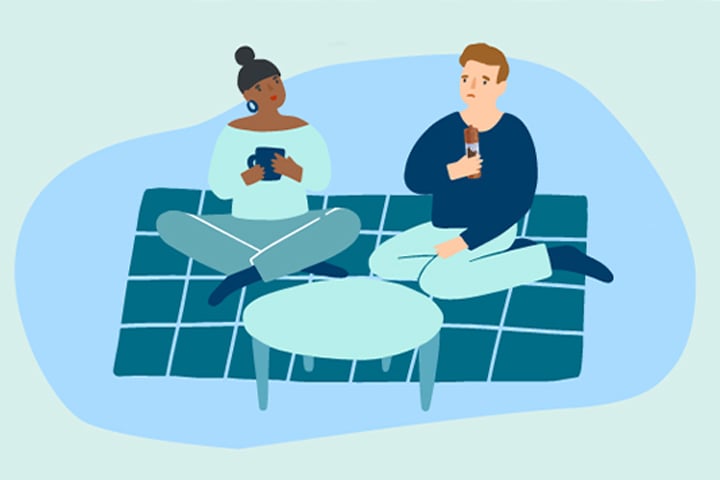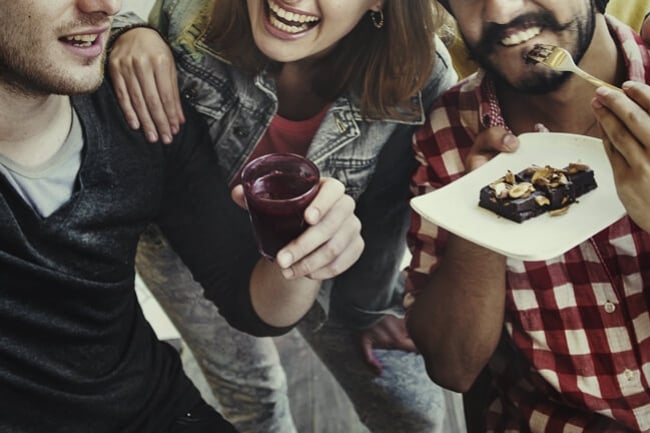.

What to Do if Someone Is Too High on Edibles
One second you were having a grand old time; the next, your buddy informed you that their brain just switched to manual breathing and the walls are closing in. Instead of just telling them to ride the wave, use some of the tips below to guide your stoned friend back to Earth in the smoothest way possible.
Edibles. Most cannabis users seem to love them or hate them. You’ll hear stories of people having either euphoric and dreamy experiences or downright waking nightmares. But how do people end up in the latter scenario? Below, you’re going to find out what constitutes an edible overdose, and what steps you can take to avoid such an occurrence.
Contents:
Can You Overdose on Edibles?
Yes. The National Institute of Health publication MedlinePlus defines[1] an overdose as “...when you take more than the normal or recommended amount of something, often a drug”. When it comes to weed, THC holds the crown as the principal intoxicating constituent. When taken in an appropriate amount, this molecule invokes feelings of creativity and euphoria. However, exceed this amount even slightly, and you could find yourself experiencing paranoia and even panic attacks.
Compared to inhaled cannabis, overdoses from edible weed are notoriously unpleasant. The primary symptoms include:
- Altered perception
- Anxiety
- Dizziness
- Weakness
- Slurred speech
- Rapid heart rate
- Low or high blood pressure
While overdosing on certain other drugs can prove fatal, the risk of death due to cannabis toxicity is negligible[2].

How Edibles Work
Cannabis edibles are so potent because they work in a slightly different way than inhaled weed. After hitting a joint or vape, THC swiftly enters the bloodstream through the alveoli of the lungs. From here, it makes its way through the blood–brain barrier and latches onto CB1 receptors of the endocannabinoid system. This mechanism of action results in fast-acting effects that wane relatively quickly. Things are different with edibles.
After orally ingesting an infused brownie, cupcake, or other THC-infused edible product, it takes time for the stomach to digest the edible vessel and liberate the contained cannabinoids. Eventually, THC permeates through the gut and beelines to the liver. Here, our major detoxification organ converts most of the THC molecule into 11-hydroxy-THC. Like “regular” THC, this metabolite also binds to CB1 receptors in the brain, but it produces a much more potent and longer-lasting high.
How to Recover From Eating Too Many Edibles
So, you’re now aware that edible overdoses are possible. But what should you do if someone is too high on edibles, or you’re having a bad reaction to edibles yourself? A lot of the time, it simply involves accepting the position you're in, instead of struggling against it. However, there are numerous strategies that you can employ to make this period much more bearable. Below, we’ll detail several easy methods you can use to gently bring yourself back down to Earth.
1. Keep Calm


It sounds obvious, but it helps. Despite feeling sensations of panic, paranoia, and impending doom, just know that everything is going to be just fine. Remember, your brain didn’t suddenly just break—you simply ate way too much of that brownie packed full of THC. In the middle of the chaos, try to tame the fight or flight response, and reactivate the rational regions of your brain. You’re literally just on drugs, and they’ll wear off eventually.
To shift your nervous system out of a sympathetic state (fight or flight) into a parasympathetic state (rest and digest), try out some deep diaphragmatic breathing, or simply go for a slow stroll with some relaxing music in your ears.
2. Hydrate


Feeling dehydrated sucks when sober, but it can have even more severe psychological consequences while you’re desperately riding the rugged waves of an edible experience gone awry. Remember the moment your red-eyed friend tried to blow your mind mid-smoke session by telling you that you’re “literally 60% water, bro”? Well, he was right. Water underpins all metabolic processes; staying hydrated therefore helps to ramp up the metabolism of THC and speed up its breakdown and excretion.
Because dehydration can amplify the effects of this intoxicating cannabinoid, it’s always a good idea to have a bottle of water or juice to hand when you take a plunge into edible land.
3. Try Black Peppercorns or CBD


It might sound a little strange, but early research shows that black pepper might help to bring relief during a bad reaction to edibles. How is this possible? Because this spice contains high quantities of the terpene beta-caryophyllene. Also known as a dietary cannabinoid, this molecule binds to the CB2 receptors of the endocannabinoid system. Researchers are currently testing[3] the phytochemical in models of anxiety.
Likewise, ongoing trials are also pitching CBD, a non-intoxicating cannabinoid found in weed buds, for its ability to offset some of the effects of THC. For example, a study[4] published in the British Journal of Pharmacology sought to analise the effects of CBD on memory deficits caused by THC.
4. Distract Yourself With a Movie or Music


Consuming too many edibles can leave you feeling awful. However, pouring all of your attention into how you’re feeling certainly won’t help. You need to pull your mind out of the loop of rumination and analysis. To achieve this, you need to direct your attention elsewhere. Start out by blasting some positive music. Not only will this help to release some feel-good neurotransmitters, but it’ll give you something enjoyable to focus on. If that fails, put on a film or show captivating enough to make you forget where you are (The Lord of the Rings never fails).
5. Wait It Out


No matter what approach you chose to take (if any), it all boils down to simply waiting until the effects of an edible overdose start to naturally wane. None of the options mentioned above are magic bullets. Sure, they help to take the edge off, but your body needs time to process the drugs you just piled into it. Again, continue to remind yourself that this is the reason you feel so weird—you’re not feeling crazy for no reason.
How Much THC Is There in a Single Edible?
The answer to this question depends on the specific product or homemade preparation. Some edibles on the market are relatively unregulated and poorly manufactured, leading to unreliable dosing and possible edible overdoses. However, matters are improving. Numerous companies have released accurately dosed products that contain the exact same amount of THC per serving. In the US, for example, edibles typically contain 5–10mg per serving, though the amount per package varies greatly.
If you’re making your own edibles at home, be sure to use our THC edible calculator to avoid a bad experience.
CBD Gummies vs THC Edibles
If you’re not a fan of THC, or simply find that CBD produces more desirable and useful effects, then you don’t need to worry too much when it comes to edible overdoses. Because CBD doesn’t produce a high, you won’t suddenly find yourself completely overwhelmed and in a bad place. With that said, too much CBD can lead to side effects, including:
- Dry mouth
- Diarrhoea
- Reduced appetite
- Drowsiness
- Fatigue
Also, keep in mind that CBD can interact with a wide range of pharmaceutical medications. Always consult with your medical professional before taking any cannabis-derived product.
Marijuana Edibles: A Great Time, as Long as You’re Prepared
Many cannabis users have an excellent time after consuming gummies, cakes, brownies, and even drinks infused with THC. They manage to achieve this by following the golden rule: go low and slow. If you’re new to edibles, take things easy and start off with small and sensible doses (2.5–5mg is often considered a good starting point). Even if you have experience with oral cannabis, you should always fire up the THC edibles calculator before making a batch of treats, to stay on the safe side.
Ver esta publicación en Instagram
DisclaimerWhen consumed, THC metabolizes into 11-hydroxy-THC, which enters the body through the stomach and liver, resulting in a significantly stronger effect due to its increased affinity for CB1 receptors in the brain.
Ensure accurate portion control. Begin with small doses and gradually increase to develop tolerance.
Remember: Set and Setting will help you deal with various situations.
Stay Cultivated.
- https://medlineplus.gov/ency/article/007287.html
- https://journals.sagepub.com/doi/full/10.1177/02698811221115760
- https://www.sciencedirect.com/science/article/abs/pii/S0031938414003400
- Cannabidiol attenuates deficits of visuospatial associative memory induced by Δ9tetrahydrocannabinol - PMC https://www.ncbi.nlm.nih.gov





































